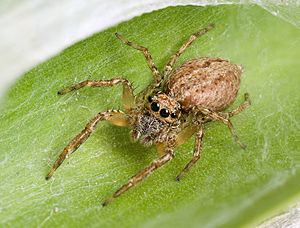Clynotis facts for kids
Quick facts for kids Clynotis |
|
|---|---|
 |
|
| Female Clynotis severus | |
| Scientific classification |
|
| Kingdom: | Animalia |
| Phylum: | Arthropoda |
| Subphylum: | Chelicerata |
| Class: | Arachnida |
| Order: | Araneae |
| Infraorder: | Araneomorphae |
| Family: | Salticidae |
| Subfamily: | Salticinae |
| Genus: | Clynotis Simon, 1901 |
| Type species | |
| C. severus (L. Koch, 1879)
|
|
| Species | |
|
5, see text |
|
Clynotis is a group of amazing spiders. They belong to a family called Salticidae, also known as jumping spiders. These spiders are found in Australia and New Zealand. Some even live on far-off islands like the Auckland Islands and Snares Island.
There are five known species in the Clynotis group. The first one, Clynotis severus, was found in Australia in 1879. The most recent one was described in 1931.
About Clynotis Spiders
Just like other jumping spiders, Clynotis spiders are known for their incredible jumping skills. They can jump with great speed and accuracy. They also have very strong eyesight.
Amazing Eyes and Jumps
You can tell Clynotis spiders apart by the unique shape of their head and chest area, called the cephalothorax. Their eye patterns are also very special. They have eight eyes in total.
The four front eyes are arranged in a row. The two middle front eyes are much bigger and stand out. The four back eyes are set up in a way that looks like two rows. The two eyes furthest back are quite large.
The front four eyes help the spider see in great detail. They can see in three dimensions. This helps them figure out how far away their prey is. It also helps them know the direction and type of bug they are hunting. This amazing vision lets them aim their jumps perfectly when they attack. The back eyes help them see things to the side.
Spider Homes
Clynotis spiders use their silk for more than just catching food. They use it as a safety line when they jump. This keeps them safe if they miss their target.
They also build small, tent-like homes out of silk. These silk tents protect them from bad weather. They also sleep in these shelters at night. Spiders use these safe spots to shed their old skin, which is called molting. They also build and store their egg cases inside these silk homes. During the colder months, they spend the winter safely tucked away in these shelters.
Species of Clynotis
As of 2019, there are five known species in the Clynotis group. They are all found in Australia and New Zealand.
- Clynotis archeyi (Berland, 1931) – Found in New Zealand (Auckland Is.)
- Clynotis barresi (Hogg, 1909) – Found in New Zealand
- Clynotis knoxi (Forster, 1964) – Found in New Zealand (Snares Is.)
- Clynotis saxatilis (Urquhart, 1886) – Found in New Zealand
- Clynotis severus (L. Koch, 1879) – This is the type species. It means it's the first species described for this group. It is found in Australia.
- Sources
- World Register of Marine Species link: Clynotis (+species list)

